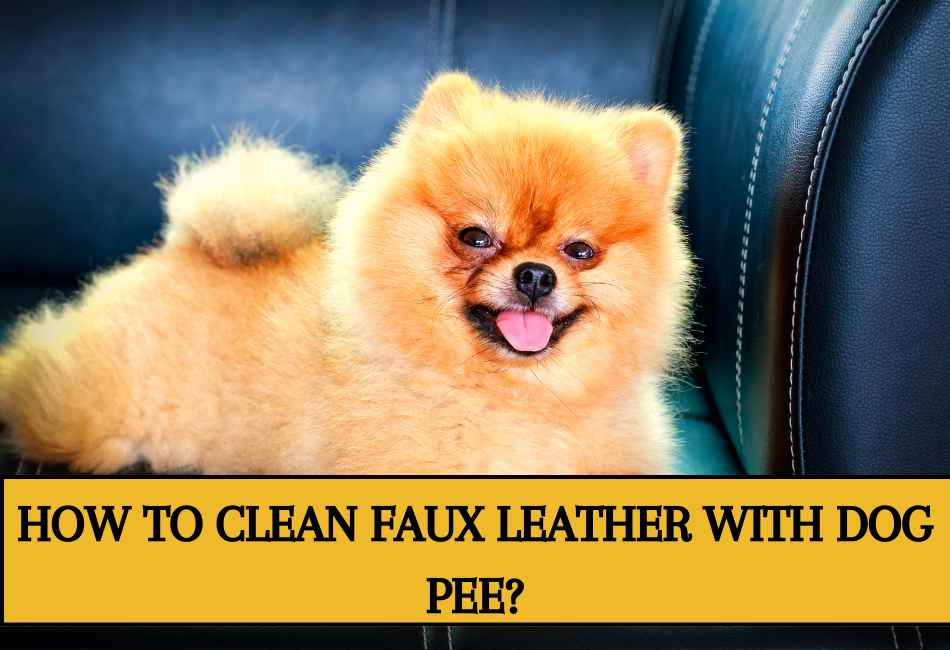Dealing with dog pee on your faux leather items can be a daunting task that dog owners often grapple with.
This challenge is about dealing with unpleasant odors and unsightly stains and maintaining the integrity of your faux leather furnishings.
Timely and efficient cleaning is paramount in this situation. Though faux leather is durable, it can be easily damaged if not cleaned properly and promptly upon contamination.
In the ensuing sections, we will guide you through three proven cleaning methods for tackling dog urine on faux leather.
These methods will ensure that you can restore your items to their previous state and keep them looking fresh for longer.
Method 1: Quick Cleanup with Household Items
Let me tell you, my journey into becoming a pet owner was not without its hurdles, and one major issue was dealing with the mess.
But I soon found that immediate action is crucial to address the issue of a peeing pooch. It might seem intimidating initially, but here’s how you do it.
Immediate action: blotting and absorbing excess urine
First things first, don’t panic! Get some paper towels or a clean cloth, and blot out as much pee as possible.
I remember when our family dog, Max, first had an accident on our brand-new faux leather sofa. We quickly acted, grabbing the nearest clean tea towel and blotting the area.
Use paper towels or a clean cloth to soak up the liquid
It’s essential to soak up the liquid initially to prevent it from seeping into the faux leather. I’ve found that using an old but clean cotton t-shirt is just as effective as paper towels, and it’s a great way to recycle old clothes too!
Applying a mixture of water and mild soap for surface cleaning
Next, a mild soap and water mix works wonders for surface cleaning. I usually keep a solution prepared in a spray bottle for such emergencies.
Dabbing the affected area with a vinegar solution to neutralize the odor
To tackle the lingering smell, a mixture of vinegar and water in equal parts is your best friend. Replacing one strong smell with another might seem odd, but the vinegar smell evaporates, taking the urine odor.
Importance of speed in preventing urine absorption and potential damage
Speed is of the essence in this process. The quicker you act, the less damage the urine can do to your faux leather items. Trust me, I learned this the hard way with our first faux leather ottoman.
Method 2: Deep Cleaning with Commercial Faux Leather Cleaners
If you have a stubborn stain or want a more thorough cleaning, a commercial cleaner designed for faux leather is a great option.
These cleaners are specifically formulated to handle the unique characteristics of faux leather. I was skeptical initially, but the results were impressive when I used one to clean up after Max’s third ‘accident’ in a month.
Selecting a cleaner suitable for faux leather and pet stains
The market is brimming with options, but choosing a faux leather-friendly cleaner designed to tackle pet stains is important.
Following the product instructions for effective application
Always stick to the instructions on the bottle for the best results. I’ve found that less is more when using these cleaners.
Testing the cleaner on a small, inconspicuous area before widespread use
To be safe, test the cleaner on a small, hidden patch of your faux leather item first. I learned this one the hard way – let’s say our faux leather chair has a small discolored patch.
Benefits of commercial cleaners in removing stubborn stains and odors
While a bit more expensive than household remedies, commercial cleaners are great for stubborn stains and odors. They saved my faux leather couch more than once, and I swear by their effectiveness now.
Method 3: Natural Remedies for Eco-Friendly Cleaning
As much as I love Max and my faux leather furniture, I also love our planet. So, I started researching natural alternatives for cleaning faux leather and found some great eco-friendly solutions!
Creating a baking soda and water paste for stain removal
One of my favorite discoveries is baking soda and water. I create a paste with equal parts, spread it on the stain, and let it sit for a few hours.
Then, I gently wipe it off with a soft cloth. The stain magically disappears, and I feel like a green domestic goddess.
Using a mixture of lemon juice and water to neutralize odor
Our four-legged friends can leave behind some unpleasant odors. Lemon juice, mixed with equal parts water, is a great natural odor neutralizer.
I spray the mixture on the odor area, let it sit for about 10 minutes, and then wipe it with a damp cloth. The lemony-fresh smell is a welcome bonus.
Application of a cornstarch solution for absorbing remaining moisture
Sometimes, even after cleaning, moisture can linger, which isn’t good for the longevity of faux leather. This is where cornstarch comes in.
I sprinkle a generous amount on the damp area and let it sit overnight. I dust off the cornstarch the next morning, and the moisture is gone!
The environmentally friendly nature of these solutions
What I appreciate most about these natural remedies is their eco-friendly nature. They are safer alternatives that do not compromise our environment’s health, making me feel responsible and empowered.
Conclusion
In our journey to protect our beloved faux leather furniture from Max’s occasional accidents, we’ve explored three main methods: household items for light cleaning, commercial cleaners for stubborn stains and odors, and natural remedies for the eco-conscious.
The key is to act swiftly and avoid letting the stain or odor sit too long. Regular maintenance is crucial for the durability and longevity of our faux leather items.
After all, I want Max to enjoy his favorite faux leather chair for many years. And remember, there’s no shame in a bit of trial and error. We’ve all been there, and our faux leather furniture is better!

